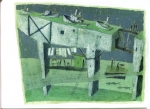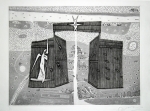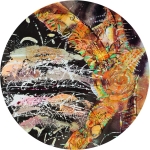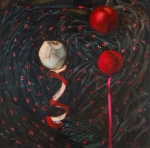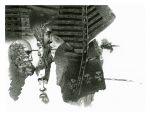Author: Ekaterina Kenigsberg
Ekaterina Kenigsberg Modern Belarusian Art: Place On MapThe variety of visual experiments is typical for modern art. In this sphere Belarusian art is rather traditional. However, the national art school does not tend to the common academic art realization. Graphic, painting, photography and other kinds of art are developing in the direction of modern visual tendencies. There is mixture of styles typical for European art.
Variety and philosophic generalization of art images is typical for Belarusian art of the last fifteen–twenty years. Exhibition activity has intensified, international plain-airs, festivals and exhibition projects are held, the artists look for their places in the main international tendencies. New generation of Belarusian artists possible to adopt various tendencies of art world appeared.
The development of Belarusian art photography during the last twenty years is characterized with the variety of genre forms, creative methods, conceptual approaches, technical diversity. Artist’s signature, numeration of print, additional negative and print processing, author’s text and stressing graphical features of a photo become typical. The modern photographers are notable for being expressive and aesthetic, for absence of stamps in their creative thinking. Among the artists of elder generation there are Mikhail Borozna, Eugeny Kazulya, Anatoly Kleschuk, Valery Lobko, Gennady Karchevsky, Vadim Kachan, Igor Savchenko, Georgy Likhtarovich; young generation - Polina Lezhanskaya, Yury Pevnev, Aleksander Vafik, Sergey Torbik and others.
Recently the artists with graphic, painting, monumental art, cinema and TV education take an interest in photography. This process directs the development of photography to the way of conceptualism. Artist’s concentration on the problem of inner world has become the original feature of the last ten years. This feature reflected the mass nation’s consciousness.
In middle of 1990s and early 2000s a number of young graphic artists, Belarusian State Art Academy graduates Pavel Tatarnikau, Yury Alisevich, Roman Sustov, Yury Jakovenko, Andrei Bassalyga made themselves known. The representatives of elder generation Nikolai Kozlov, Valery Slauk, Vladimir Vishnevsky, Lev Alimov work actively too widening genre, visual and technical variety of Belarusian easel and book graphic. There expended syncretism in graphic methods and two-way influence of arts took place. Photographics, collage, mixed techniques are extensively used; since the end of 1990s the means of computer graphic are used. The representatives of Belarusian graphic school have positive responses from art critics in specialized mass media and are awarded at art exhibitions and book fairs (Yury Jakovenko and Anzhela Malysheva won the Grand Prix of international engraving biennale “Jozep de Ribera”, Spain; Pavel Tatarnikau won two premiums “Gold Apple” of international illustration biennale in Bratislava).
Belarusian easel painting of the last years is characterized of revival of interest to the painting with stressed colorostic features. The large-size thematic pictures typical of soviet art disappeared. The originality of plastic language and fullness of aesthetic effect cause an interest. The art of metaphor and conception changes the art of theme.
Both the conservation of traditions of academic mastery and experiments with new materials and technologies are typical of Belarusian plastic art.
The art educational system in Belarus hasn’t significantly changed: child art school – college of art – academy of art. The Belarusian State Academy of Arts is the single academy in the country, providing higher education in the field of graphics, painting, plastic art, monumental, decorative and applied arts, design, art criticism. There is also an opportunity to get higher education at the Vitebsk State University, at the Belarusian State Culture and Art University.
The Belarusian Artist Union, playing an important role in the Belarusian art life, owns the largest exhibition hall in Minsk (the square is more than 1000 square meters) as well as the exhibition halls in all largest cities of the country. Since 1998 the Museum of Modern Fine Art has been functioning in Minsk. The exhibitions of modern art are held in the Museum of Belarusian State Academy of Arts, the National Art Museum of the Republic of Belarus, the National Museum of History and Culture in Minsk, the Regional Art Museum by P.V. Maslenikov in Mogilev, the Art Gallery by G.H.Vaschenko in Gomel, the Art Gallery in Polotsk, museums and galleries in Grodno, Vitebsk, Brest, Baranovichi. There are only a few private galleries in Belarus, and all of them are exhibitions of modern art.
The existence of art is always depends on publicity. The definition of publicity as the expression of human efforts which are directed to organize the public process contradicts the belief in new communications and technologies connecting people. During the last ten years the art in public space has underwent significant genre and technical changes. The sphere of art existence has changed itself, political and social contexts have been transformed. Nevertheless, the term “art in public space” is regarded as monumental art by many people. It’s clear, because, first, the monumental art traditionally carries out aesthetic, memorial and educational functions, and, secondly, only traditional forms and kinds of graphic art are supposed by a great number of people to be real art. Because of global and local political and social changes of the end of the twenty century many historical monuments has been regarded as “epoch scent”. Modern art in public space tends to become a means of integration between public interests and public space.
There is not a lot of space for graphic self-expression in a modern rationally organized and structured urban space. Street art, graffiti are used in any accessible space. New sculptures, stained-glass windows, graffiti, mosaics are created. There is a process of interaction between graphic and social space. Artists are interested in transition from museum and gallery halls to public space.
Belarusian art is still suffering from long lasting isolation. There are no biennale, triennale and other large international exhibitions of modern art in the state. Belarusian artists have not taken part formally in the most significant exhibitions of world art yet. Belarus is still terra incognita for the most European curators and art critics. And the problem is not only the existence of language barrier. And if an average European curator uses internet to find information about the art of a country, than such a method is not reliable for Belarus. Many Belarusian museums and galleries have their web-sites, but, as a rule, there are no review articles of the leading Belarusian art experts and critics there. Overwhelming majority of Belarusian artists don’t have their web-sites.
So, it’s clear why foreign curators don’t work with Belarusian artists in general, or work with Belarusian emigrants graduated from European art academies and living in the west, or with some Belarusian artists, having contacts with European and American galleries.
Unfortunately, the question ”where is Belarus located?” is still urgent for European spectators. And to the present days many foreign newspapers and magazines sent by post to Minsk libraries are addressed to “Minsk, the Ukraine”, or “Minsk, Russia”.

